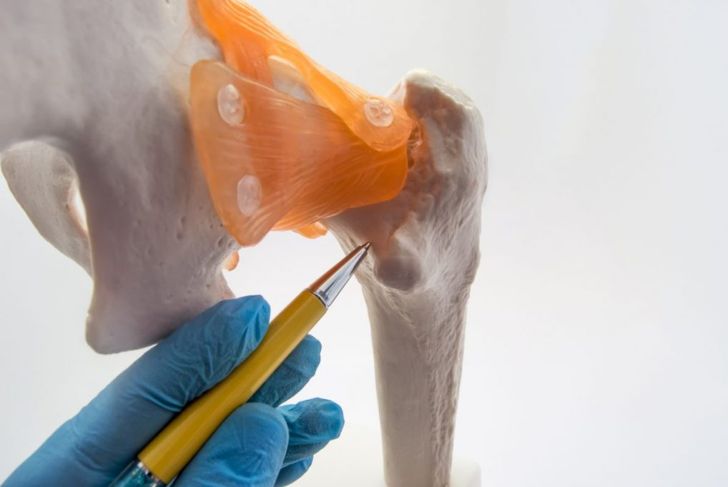The femoral neck is a bone that connects the head of the femur to the shaft. The neck is significantly thinner than other parts of the femur, making it prone to fractures. Despite the femur being a thigh bone, femoral fractures are hip fractures due to the femoral neck’s proximity to the hip joint. Experts find nearly half of all hip fractures are femoral neck fractures, because the femur and hip joint carry varying loads and tend to weaken with age.
Who is most likely to have a femoral neck fracture?
Adults over the age of 65 who have osteoporosis are the most likely to experience femoral neck fractures. Younger people who have femoral neck fractures make up just three to ten percent of instances but can be anywhere from 12 to 50 years old. Women are more likely to fracture their hips than men. The United States has one of the highest incident rates of hip fractures in the world, though it is dropping. People who consume excess alcohol also appear to have higher rates of injury, though this could be due more to their higher chance of falling than any physiological changes.
How do more femoral neck fractures occur?
In older adults, femoral neck fractures are often fragility fractures caused by falls or trauma. This is particularly true for people osteoporosis, who have weakened bones. The vast majority of femoral neck fractures in young adults happen because of major traumatic events such as car accidents.
Why is it important to know the cause?
Understanding how a femoral neck fracture occurred is a necessary factor in determining proper treatment. A young person who experiences a femoral neck fracture from a low-energy trauma requires further examination — it is possible the fracture is the result of osteoporosis, even in younger patients. Pathologic bones, those that have been broken previously, can also cause femoral neck fractures. If a high-energy incident caused the fracture, the individual may have other injuries that could complicate treatment.
What types of femoral neck fractures are there?
There are several different classifications of femoral neck fractures. Each is used in specific contexts to provide relevant information, and are determined based on the type of fracture the individual sustained. The types of fractures are subcapital, transcervical, and basicervical. Subcapital is the most common and occurs in the junction of the head and neck of the femur. Transcervical fractures occur in the midportion of the neck. Basicervical fractures happen at the base of the neck.
What are the classifications of femoral neck fractures?
There are two methods of classifying femoral neck fractures. The first, the Garden classification, has four stages that each describe a method of fracture. Stage I is an incomplete fracture that features joint deformity called valgus, while stage II is a complete fracture that moves and maintains its proper placement. Stage III is a partially moved or displaced fracture that is complete, and stage IV is a complete fracture that is severely displaced. The second method of classification is Pauwels’ angles and describes the inclination of the fracture lines. Degree I is up to 30 degrees, Degree II is between 30 and 50, and Degree III is 50 degrees or more.
Is it possible to have a fracture and not realize it?
It is possible for an individual never to realize he or she has a fracture. Most individuals experience pain in the affected limb, especially when moving or rotating it. Young people, however, may have a more elusive diagnosis. In the case of ipsilateral femoral neck fractures, the diagnosis was missed almost 30% of the time. Despite the bone being fractured all the way through, it can still move and rotate without issue. This makes it essential for doctors to carefully examine any patient who has experienced a high-energy trauma event.
What side effects could the fracture cause?
The pain caused by the fracture is the most immediate issue, and for most people will be the only issue they face. Without treatment, the death of bone tissue or avascular necrosis can occur and lead to total bone collapse. There is also the potential for non-union, a condition where the bone begins to heal incorrectly, causing deformities and serious pain. Even surgeries to treat the fracture can have complications that lead to pneumonia, blood clots, bleeding, and infections. It is likely that even without complications, people who experience femoral neck fractures will have loss of mobility and independence, at least temporarily.
Why is the femoral neck prone to fractures?
The femoral neck has a variety of loads and forces acting on it at any given time, due to its placement near the hip joint. Additionally, the femoral neck is pyramidal, with a wide base but a thinner top where it connects to the femoral head. This shape, combined with pressure, makes it prone to fractures. Additionally, the length of the neck varies from person to person, and those with particularly long bones can deal with more weakness.
What are the treatment options for older adults?
For people under the age of 80, treatment focuses less on chronological age and more on physiologic age. Activity level and bone quality are important factors in developing a treatment. Standard treatment involves fixing the fracture in its original place, using screws or a sliding screw and plate device. If the fracture is displaced, such as in Stage III and IV of Garden’s classification, the surgeon may replace the broken part of the bone with a metal implant. Patients who are still active may receive a total hip replacement.
What are the treatment options for younger patients?
Doctors treat femoral neck fractures in younger patients with the primary goal of maintaining mobility. Thankfully, younger patients tend to have significantly higher union rates than older patients, which helps the bones heal properly. One of the preferred surgeries to treat young people is the placement of pins and screws to align the bones properly and allow them to heal naturally. This may not be possible for people with underlying issues such as poor bone density or osteoporosis; these individuals may require hip replacements or implants.

 Home
Home Health
Health Diet & Nutrition
Diet & Nutrition Living Well
Living Well More
More




















